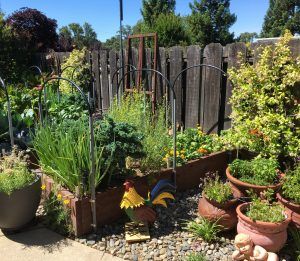DIY Color Bowls
You know what they are, those front and center displays when you head into the garden center. They say, “Pick me, pick me!” The carefully selected, seasonal, potted flowers and plants are in their glory. No waiting for those bulbs to show here. The combinations of colors and textures are stunning. However, many times they can be pricey. Why not make your own with those pots or unique vessels you’ve been meaning to plant or reuse (the ones stashed under your deck or in your shed)? There are many books, magazines, and online articles on container gardening, but, really, you can keep it very simple.
The container or vessel:
- Consider the material of the vessel. Clay or terra cotta pots are porous, and will require more frequent watering. Other good options that are non-porous are plastic, glazed and cement.
- Recycled containers should be disinfected with a bleach solution of 9 parts water to 1-part bleach.
- Insure you have drainage holes; you can drill them if they aren’t there already.
- Cover the drainage hole with a few shards of broken pottery, but don’t block the hole so water drains freely.
- The size of the container will be important during plant selection. Perennials and taller plants often times have larger root systems. Larger and deeper is better.
Soil:
- Choose a potting mix or potting soil formulated specifically for containers. These are ideal for healthy root growth as they hold moisture and provide good drainage.
- Some potting soils contain pre-mixed fertilizer, so be careful not to over fertilize.
Plants: A common way to think about plants for a container is “thriller, filler and spiller” or “tall, sprawl and fall.”
- Thriller (tall) is an upright eye-catching plant that is placed in the center of the pot. It usually has a distinct form or texture. “Tall” in reference to the other plants is subjective to your choosing.
- Filler (sprawl) plants anchor the taller thriller and fill in with a mounded form. The color can be from foliage or flowers, but this plant selection should provide some color.
- Spiller (fall) is a trailing or falling plant that hangs over the edge of the container. This gives an illusion of fullness. It can be colorful, or it can be just a complement to the other plants.
Water:
- Container plants need water and dry out quickly, so water thoroughly and consistently.
- Your watering schedule will depend on the plants you selected and their sun exposure.
- On warmer and windy days, water requirements will increase.
Fertilization:
- Containers require more consistent fertilization as watering leaches nutrients out of the soil.
- Apply a light dose of fertilizer with every watering or include a slow-release dry fertilizer in the soil (unless soil contains fertilizers already).
Here are a few summer-blooming, full-sun combinations to consider. You can modify your container plants based on your garden center’s availability and by following the “T” (thriller), “F” (filler) and “S” (spiller) as noted above:
- T-blue oat grass (Helictotrichon sempervirens), F-French marigold (Tagetes cultivar), S-rock rose (Helianthemum cultivar)
- T-fountain grass ‘Purple Majesty’ (Pennisetum glaucum), F-lantana ‘Bandana Red’ (L. camera/L. montevidensis), S-sweet potato vine ‘Margarita’ (Ipomoea batatas)
- T-geranium cranesbill (Geraniaceae sanguineum), F-white alyssum (Lobularia maritima), S-lobelia ‘Blue Star’ (Lobelia campanulaceae)
- And, for a vegetable, herbal variation: T-eggplant ‘Patio Baby’ (Solanaceae) F-curly parsley, S-thyme, tricolor sage, and/or oregano
Ann Arshakuni is a University of California Cooperative Extension Master Gardener of Tuolumne County.

